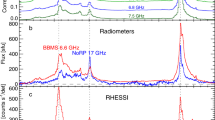Abstract
The data from OGO-5 and OSO-7 X-ray experiments have been compared with optical data from six chromospheric flares with filament disruption associated with slow thermal X-ray bursts. Filament activation accompanied by a slight X-ray enhancement precedes the first evidence of Hα flare by a few minutes. Rapid increase of the soft X-ray flux accompanies the phase of fastest expansion of the filament. Plateau or slow decay phases in the X-ray flux are associated with slowing and termination of filament expansion. The soft X-ray flux increases as F∼(A + Bh) h, where h is the height of the disrupted prominence at any given time and A and B are constants. We suggest that the soft X-ray emission originates from a growing shell of roughly constant thickness of high-temperature plasma due to the compression of the coronal gas by the expanding prominence.
Similar content being viewed by others
References
Brown, J. C.: 1974, Solar Phys. 36, 371.
Datlowe, D. W., Hudson, H. S., and Peterson, L. E.: 1974a, Solar Phys. 35, 193.
Datlowe, D. W., Elcan, M., and Hudson, H. S.: 1974b, Solar Phys. 39, 155.
Drake, J. F.: 1971, Solar Phys. 16, 152.
Harrington, T. M., Maloy, J. O., McKenzie, D. L., and Peterson, L. E.: 1972, IEEE Trans. Nuc. Sci. NS-19, 596.
Hudson, H. S. and Okhi, K.: 1972, Solar Phys. 23, 155.
Hyder, C. L. and Lites, B. W.: 1970, Solar Phys. 14, 147.
Kane, S. R. and Anderson, K. A.: 1970, Astrophys. J. 162, 1003.
Kane, S. R. and Hudson, H. S.: 1970, Solar Phys. 14, 414.
Kane, S. R., Kreplin, R. W., Martres, M. J., Pick, M., and Soru-Escaut, I.: 1974, Solar Phys. 38, 483.
Martin, S.: 1973, Solar Phys. 31, 3.
Neupert, W. M., Thomas, R. J., and Chapman, R. D.: 1974, Solar Phys. 34, 349.
Phillips, K. J. H., Neupert, W. M., and Thomas, R. J.: 1974, Solar Phys. 36, 383.
Purcell, J. D. and Widing, K. G.: 1972, Astrophys. J. 176, 239.
Rompolt, B.: 1967, Acta Astron. 17, 329.
Roy, J. R.: 1973a, Solar Phys. 28, 95.
Roy, J. R.: 1973b, Solar Phys. 32, 139.
Rust, D. M. and Roy, J. R.: 1974, The late June 1972 ‘CINOF’ Flares, AFCRL Research Report TR-74-0201.
Saito, K. and Billings, D. E.: 1964, Astrophys. J. 140, 760.
Smith, S. F. and Ramsey, H. E.: 1964, Z. Astrophys. 60, 1.
Tanaka, K. and Nakagawa, Y.: 1973, Solar Phys. 33, 187.
Tandberg-Hanssen, E. and Malville, J.: 1974, Solar Phys. 39, 107.
Thomas, R. J. and Teske, R. G.: 1971, Solar Phys. 16, 431.
Walter, A. B. C., Jr. and Rugge, H. R.: 1970, Astron. Astrophys. 5, 4.
Zirin, H., Ingham, W., Hudson, H., and McKenzie, D.: 1969, Solar Phys. 9, 269.
Author information
Authors and Affiliations
Additional information
Part of this work was carried out while at Big Bear Solar Observatory, CALTECH, Pasadena, California, U.S.A.
Rights and permissions
About this article
Cite this article
Roy, JR., Tang, F. Slow X-ray bursts and flares with filament disruption. Sol Phys 42, 425–439 (1975). https://doi.org/10.1007/BF00149923
Received:
Published:
Issue Date:
DOI: https://doi.org/10.1007/BF00149923



